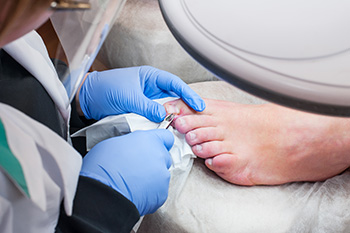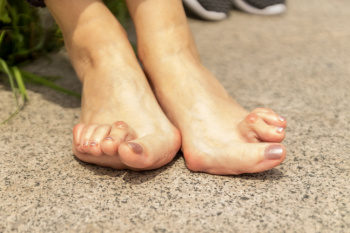Items filtered by date: May 2024
Treatment Options for Ingrown Toenails

Ingrown toenails are characterized by the downward curling of the toenail's side or corner into the adjacent skin. An ingrown toenail typically results in redness, swelling, tenderness, and in some cases becomes infected. While frequently seen in the big toe, any toenail can become ingrown. The major causes of ingrown toenails include wearing ill-fitting footwear, improper nail trimming techniques, and traumatic injury to the toe. Seeking professional evaluation by a podiatrist is essential for an accurate diagnosis and appropriate treatment. For mild cases, conservative measures such as warm water soaks and placement of a cotton ball beneath the affected nail corner may provide relief. However, persistent or worsening symptoms warrant prompt intervention to prevent complications, including bacterial infection. In such instances, treatment may involve antibiotic therapy or, in severe cases, surgical removal of the ingrown portion of the nail. Among the ways to prevent an ingrown toenail are trimming nails straight and wearing shoes that fit properly. If you have an ingrown toenail, especially if pain is persistent, it is suggested that you schedule an appointment with a podiatrist for a complete exam and treatment suggestions.
Ingrown toenails may initially present themselves as a minor discomfort, but they may progress into an infection in the skin without proper treatment. For more information about ingrown toenails, contact one of our podiatrists of Apple Podiatry Group. Our doctors can provide the care you need to keep you pain-free and on your feet.
Ingrown Toenails
Ingrown toenails are caused when the corner or side of a toenail grows into the soft flesh surrounding it. They often result in redness, swelling, pain, and in some cases, infection. This condition typically affects the big toe and may recur if it is not treated properly.
Causes
- Improper toenail trimming
- Genetics
- Improper shoe fitting
- Injury from pedicures or nail picking
- Abnormal gait
- Poor hygiene
You are more likely to develop an ingrown toenail if you are obese, have diabetes, arthritis, or have any fungal infection in your nails. Additionally, people who have foot or toe deformities are at a higher risk of developing an ingrown toenail.
Symptoms
Some symptoms of ingrown toenails are redness, swelling, and pain. In rare cases, there may be a yellowish drainage coming from the nail.
Treatment
Ignoring an ingrown toenail can have serious complications. Infections of the nail border can progress to a deeper soft-tissue infection, which can then turn into a bone infection. You should always speak with your podiatrist if you suspect you have an ingrown toenail, especially if you have diabetes or poor circulation.
If you have any questions, please feel free to contact our offices located in Arlington Fort Worth, And Flower Mound, TX . We offer the newest diagnostic and treatment technologies for all your foot care needs.
Gout Pain Can Be Managed
How Rheumatoid Arthritis Can Impact Feet

Rheumatoid arthritis, or RA, a chronic autoimmune disorder, can relentlessly target the feet, causing considerable discomfort and impairing mobility. In RA, the immune system mistakenly attacks healthy tissues, leading to inflammation in the joints, including those in the feet. The toe joints, ankle joints, and subtalar joints are often affected, resulting in pain, stiffness, swelling, and deformities like bunions and hammertoes. Managing RA in the feet requires a multifaceted approach. Medications such as nonsteroidal anti-inflammatory drugs, disease-modifying anti-rheumatic drugs, and biologic agents can alleviate symptoms and slow disease progression. Custom orthotics and supportive footwear aid in maintaining foot function and reducing discomfort. In severe cases where joint damage is significant and conservative treatments prove ineffective, surgery may be necessary to repair or replace damaged joints. If you are feeling the effects of RA in your feet, it is suggested that you consult a podiatrist for tailored management strategies and ways to improve overall foot health.
Because RA affects more than just your joints, including the joints in your feet and ankles, it is important to seek early diagnosis from your podiatrist if you feel like the pain in your feet might be caused by RA. For more information, contact one of our podiatrists of Apple Podiatry Group. Our doctors will assist you with all of your podiatric concerns.
What Is Rheumatoid Arthritis?
Rheumatoid Arthritis (RA) is an autoimmune disorder in which the body’s own immune system attacks the membranes surrounding the joints. Inflammation of the lining and eventually the destruction of the joint’s cartilage and bone occur, causing severe pain and immobility.
Rheumatoid Arthritis of the Feet
Although RA usually attacks multiple bones and joints throughout the entire body, almost 90 percent of cases result in pain in the foot or ankle area.
Symptoms
- Swelling and pain in the feet
- Stiffness in the feet
- Pain on the ball or sole of feet
- Joint shift and deformation
Diagnosis
Quick diagnosis of RA in the feet is important so that the podiatrist can treat the area effectively. Your doctor will ask you about your medical history, occupation, and lifestyle to determine the origin of the condition. Rheumatoid Factor tests help to determine if someone is affected by the disease.
If you have any questions please feel free to contact our offices located in Arlington Fort Worth, And Flower Mound, TX . We offer the newest diagnostic and treatment technologies for all your foot and ankle needs.
Ankle Pain and Arthritis
 Ankle pain can be a symptom of various types of arthritis, each with distinct characteristics and causes. Osteoarthritis, often associated with aging, occurs when the protective cartilage cushioning the ends of the bones wears down over time. This leads to pain and stiffness in the ankle. Rheumatoid arthritis, or RA, is an autoimmune condition where the immune system mistakenly attacks the joints, including those in the ankle. Inflammation, swelling, and pain in the ankles are common symptoms. Gout, another form of arthritis, is caused by the buildup of uric acid crystals in the joints. This condition can lead to sudden, severe attacks of pain and redness in the ankle. There are different treatment strategies for each type of arthritis, including medication and lifestyle changes. In some cases, surgery may be necessary to relieve symptoms and improve joint function. A podiatrist, or foot doctor, can help diagnose the specific type of arthritis causing ankle pain through clinical evaluation and imaging tests. If you have ankle pain, it is suggested that you make an appointment with a podiatrist for diagnosis and a personalized treatment plan.
Ankle pain can be a symptom of various types of arthritis, each with distinct characteristics and causes. Osteoarthritis, often associated with aging, occurs when the protective cartilage cushioning the ends of the bones wears down over time. This leads to pain and stiffness in the ankle. Rheumatoid arthritis, or RA, is an autoimmune condition where the immune system mistakenly attacks the joints, including those in the ankle. Inflammation, swelling, and pain in the ankles are common symptoms. Gout, another form of arthritis, is caused by the buildup of uric acid crystals in the joints. This condition can lead to sudden, severe attacks of pain and redness in the ankle. There are different treatment strategies for each type of arthritis, including medication and lifestyle changes. In some cases, surgery may be necessary to relieve symptoms and improve joint function. A podiatrist, or foot doctor, can help diagnose the specific type of arthritis causing ankle pain through clinical evaluation and imaging tests. If you have ankle pain, it is suggested that you make an appointment with a podiatrist for diagnosis and a personalized treatment plan.
Ankle pain can have many different causes and the pain may potentially be serious. If you have ankle pain, consult with one of our podiatrists from Apple Podiatry Group. Our doctors will assess your condition and provide you with quality foot and ankle treatment.
Ankle pain is any condition that causes pain in the ankle. Due to the fact that the ankle consists of tendons, muscles, bones, and ligaments, ankle pain can come from a number of different conditions.
Causes
The most common causes of ankle pain include:
- Types of arthritis (rheumatoid, osteoarthritis, and gout)
- Ankle sprains
- Broken ankles
- Achilles tendinitis
- Achilles tendon rupture
- Stress fractures
- Tarsal tunnel syndrome
- Plantar fasciitis
Symptoms
Symptoms of ankle injury vary based upon the condition. Pain may include general pain and discomfort, swelling, aching, redness, bruising, burning or stabbing sensations, and/or loss of sensation.
Diagnosis
Due to the wide variety of potential causes of ankle pain, podiatrists will utilize a number of different methods to properly diagnose ankle pain. This can include asking for personal and family medical histories and of any recent injuries. Further diagnosis may include sensation tests, a physical examination, and potentially x-rays or other imaging tests.
Treatment
Just as the range of causes varies widely, so do treatments. Some more common treatments are rest, ice packs, keeping pressure off the foot, orthotics and braces, medication for inflammation and pain, and surgery.
If you have any questions, please feel free to contact our offices located in Arlington Fort Worth, And Flower Mound, TX . We offer the newest diagnostic and treatment technologies for all your foot care needs.

